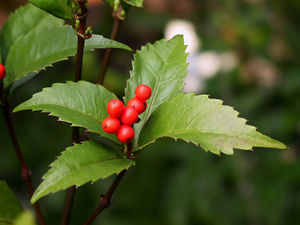Sarcandra glabra
From Wikiwel
Other Names : Cao Shan Hu, Jiu Jie Cha, Guan yin cha, Senryo, herba sarcandrae, glabrous sarcandra herb
Sarcandra glabra is an herb native to Southeast Asia.
Health Benefits and Uses of Sarcandra glabra
Sarcandra Glabra is a warm herb and can have both a bitter and sweet taste. It is a Wind-dispelling, anti-inflammatory and pain-relieving antimicrobial and antitumor herb (Dong et al., 1998). Pungent in taste and neutral, it acts on the large intestine meridian.
- Strong detoxifying properties, helping to clear heat and toxic material. It can especially enhance cellular energy production.
- It also has nonspecific anti-inflammatory activity
- Broad spectrum antimicrobial : to treat a great number of infectious diseases, including pneumonia, acute appendicitis, acute gastroenteritis, cholecystitis, bacterial dysentery, boils and abscesses and it relieves pain associated with the infection.
- Has been used to promote circulation.
- It has been used in traditional Chinese medicine for the treatment of bruises, bone fractures, arthritis, nausea, internal pain, joint swelling and cough.
- It has been proposed for the treatment of chemotherapy-induced thrombocytopenia and idiopathic thrombocytopenic purpura.
- In one clinical observation in China, Sarcandra glabra was shown to increase platelet production.
- This herb is also believed to posses a regulatory action on immunity.
- Antitumorous : to treat prostate, colon, stomach, pancreas and esophageal cancers, sarcanda is commonly used with other antitumorous herbs. For a tea, boil 60g of this herb and drink it three times a day for three months. In studies reported by seventeen cancer treatment units in Shangai City, Sarcanda was shown to be an effective treatment for prostate cancer for 62 percent of the patients who drank this tea. The patients' cancer dissipated, their appetite increased, and their lives were extended (Dong et al., 1998)
- relives arthralgia : This herb dispels pathogenic Wind and relieves arthritis pain. It is commonly prescribed with cnidium, clematis and other herbs in decoction.
References
- Hocking, G.M., A Dictionary of Natural Products. 1997, Medford, NJ: Plexus Publishing, Inc.
- Hson-Mou Chang and Paul Pui-Hay, Pharmacology and Applications of Chinese Materia Medica, World Scientific Pub Co Inc (May 2000), pages 30-37
- Pathogeny-Pathology Department, Institute of Materia Medica of Jiangxi College of Traditional Chinese Medicine. The effects of Sarcandra Glabra on the immunologic function of organ. 1976
- Zhejiang Coordinating Group on the Clinical Studies of Sarcandra glabra, Xienyiyaoxue Zazhi (Journal of Traditional Chinese Medicine) 1979
- Zhong, L., et al., The study on effect of Sarcandra glabra on prevention and treatment of thrombocytopenia by chemotherapy. Zhong Yao Cai 2005. 28(1): p. 35.
- Zhang, J.Z., Clinical observation of 26 cases of idiopathic thrombocytopenic purpura treated with Sarcandra glaber. J Tradit Chin Med 1981. 1(1): p. 61-2.
